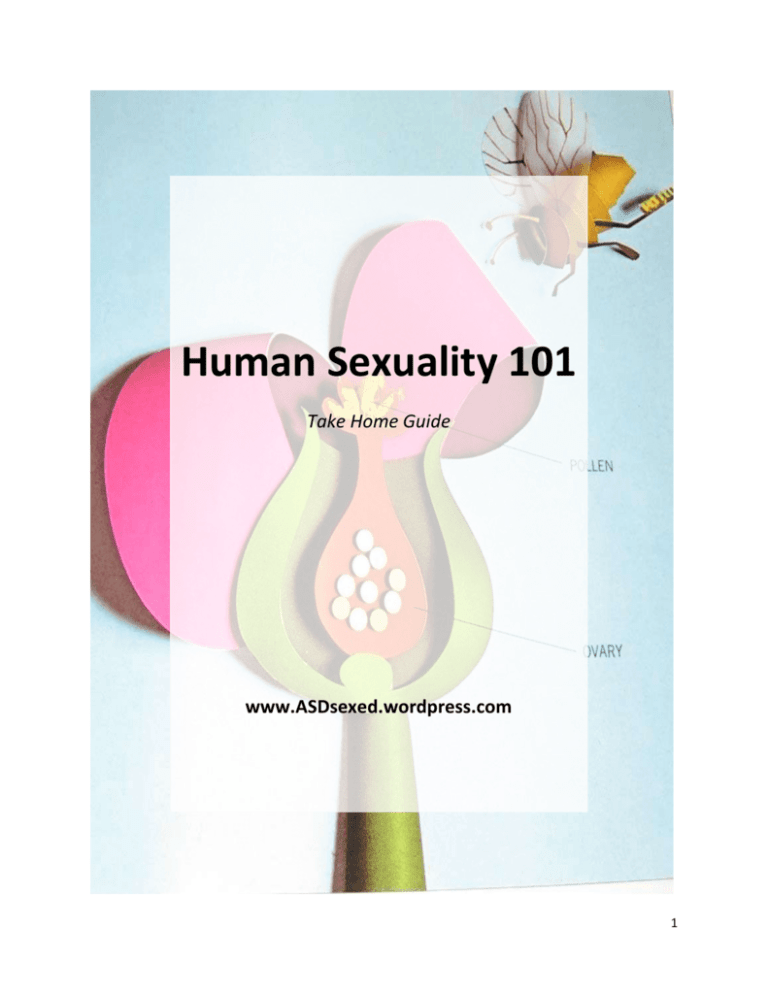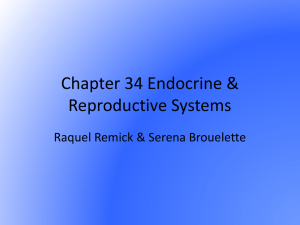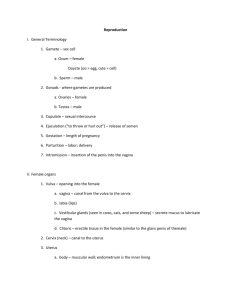
Human Sexuality 101
Take Home Guide
www.ASDsexed.wordpress.com
1
What is human sexuality?
Sometimes human sexuality topics make us feel uncomfortable, but it’s a part of
life, specifically, part of our private life. Human sexuality is about how we feel
about people like loving someone and liking someone, but sometimes two
people’s feelings may not match with each other. Human sexuality has to do with
emotions, the body, and relationships
2
Anatomy
Anatomy means parts of the body. In our class, we focused on the parts of the
body related to reproduction. Another way of saying this is sex organs or private
parts. We might have a lot of feelings when we’re talking about this, like
embarrassment, excitement, we might feel silly, or be curious. No matter what you
feel, your feelings are okay.
Some general ideas…
Women’s reproductive organs are inside the body and men’s are mostly
outside the body.
Reproductive body parts are a system of tubes, canals, and storage centers
that connect to one another.
Male and female reproductive body parts produce genetic information and
try to bring it together.
3
Male Reproductive Anatomy Picture
When I think about these body parts, I feel…
__________________________________________________________
__________________________________________________________
__________________________________________________________
4
Male Reproductive Anatomy Definitions and Functions
From WebMD
Penis: Used for reproduction, urination, and pleasure.
This is the male organ used in sexual
intercourse. It has three parts: the root,
which attaches to the wall of the
abdomen; the body, or shaft; and the
glans, which is the cone-shaped part at the
end of the penis. The glans, also called the
head of the penis, is covered with a loose
layer of skin called foreskin. This skin is
sometimes removed in a procedure called
circumcision. The opening of the urethra,
the tube that transports semen and urine, is at the tip of the penis. The penis also contains a
number of sensitive nerve endings.
The body of the penis is cylindrical in shape and consists of three circular shaped chambers.
These chambers are made up of special, sponge-like tissue. This tissue contains thousands of
large spaces that fill with blood when the man is sexually aroused. As the penis fills with blood,
it becomes rigid and erect, which allows for penetration during sexual intercourse. The skin of
the penis is loose and elastic to accommodate changes in penis size during an erection.
Semen, which contains sperm (reproductive cells), is expelled (ejaculated) through the end of
the penis when the man reaches sexual climax (orgasm). When the penis is erect, the flow of
urine is blocked from the urethra, allowing only semen to be ejaculated at orgasm.
Scrotum: A tissue sack that holds the testes.
This is the loose pouch-like sac of skin that hangs behind and below the penis. It contains the
testicles (also called testes), as well as many nerves and blood vessels. The scrotum acts as a
"climate control system" for the testes. For normal sperm development, the testes must be at a
temperature slightly cooler than body temperature. Special muscles in the wall of the scrotum
allow it to contract and relax, moving the testicles closer to the body for warmth or farther away
from the body to cool the temperature.
5
Testicles (testes): Produces sperm (men’s genetic information).
These are oval organs about the size
of large olives that lie in the
scrotum, secured at either end by a
structure called the spermatic cord.
Most men have two testes. The
testes are responsible for making
testosterone, the primary male sex
hormone, and for generating sperm.
Within the testes are coiled masses
of tubes called seminiferous
tubules. These tubes are
responsible for producing sperm
cells.
Epididymis: Where sperm mature.
The epididymis is a long, coiled tube that rests on the backside of each testicle. It transports and
stores sperm cells that are produced in the testes. It also is the job of the epididymis to bring the
sperm to maturity, since the sperm that emerge from the testes are immature and incapable of
fertilization. During sexual arousal, contractions force the sperm into the vas deferens.
Vas deferens: Brings sperm to the urethra.
The vas deferens is a long, muscular tube that travels from the epididymis into the pelvic cavity,
to just behind the bladder. The vas deferens transports mature sperm to the urethra, the tube
that carries urine or sperm to outside of the body, in preparation for ejaculation.
Ejaculatory ducts: A connector.
These are formed by the fusion of the vas deferens and the seminal vesicles (see below). The
ejaculatory ducts empty into the urethra.
6
Urethra: Carries urine and semen out of the body.
The urethra is the tube that carries urine from the bladder to outside of the body. In males, it
has the additional function of ejaculating semen when the man reaches orgasm. When the penis
is erect during sex, the flow of urine is blocked from the urethra, allowing only semen to be
ejaculated at orgasm.
Seminal vesicles: Produces sperm energy.
The seminal vesicles are sac-like pouches that attach to the vas deferens near the base of the
bladder. The seminal vesicles produce a sugar-rich fluid (fructose) that provides sperm with a
source of energy to help them move. The fluid of the seminal vesicles makes up most of the
volume of a man's ejaculatory fluid, or ejaculate.
Prostate gland: Produces sperm energy.
The prostate gland is a walnutsized structure that is located
below the urinary bladder in front
of the rectum. The prostate gland
contributes additional fluid to the
ejaculate. Prostate fluids also help
to nourish the sperm. The urethra,
which carries the ejaculate to be
expelled during orgasm, runs
through the center of the prostate
gland.
Bulbourethral glands: Produces lubricant (makes things slippery).
Also called Cowper's glands, these are pea-sized structures located on the sides of the urethra
just below the prostate gland. These glands produce a clear, slippery fluid that empties directly
into the urethra. This fluid serves to lubricate the urethra and to neutralize any acidity that may
be present due to residual drops of urine in the urethra.
7
Female Reproductive Anatomy Picture
When I think about these body parts I feel…
__________________________________________________________
__________________________________________________________
__________________________________________________________
8
Female Reproductive Definitions and Functions
From WebMD
Labia majora: Skin that protects the vulva (outside part of a woman’s sexual system)
The labia majora enclose
and protect the other
external reproductive
organs. Literally
translated as "large lips,"
the labia majora are
relatively large and
fleshy, and are
comparable to the
scrotum in males. The
labia majora contain
sweat and oil-secreting
glands. After puberty, the
labia majora are covered
with hair.
Labia minora: Skin that protects the opening to the vagina
Literally translated as "small lips," the labia minora can be very small or up to 2 inches wide.
They lie just inside the labia majora, and surround the openings to the vagina (the canal that
joins the lower part of the uterus to the outside of the body) and urethra (the tube that carries
urine from the bladder to the outside of the body).
Bartholin's glands: Produces fluid
These glands are located next to the vaginal opening and produce a fluid (mucus) secretion.
9
Clitoris: Skin and nerves that cause pleasure
The two labia minora meet at the clitoris, a small,
sensitive protrusion that is comparable to the penis
in males. The clitoris is covered by a fold of skin,
called the prepuce, which is similar to the foreskin
at the end of the penis. Like the penis, the clitoris is
very sensitive to stimulation and can become erect.
Vagina: The first inside part of a woman’s sexual
system
The vagina is a canal that joins the cervix (the lower
part of uterus) to the outside of the body. It also is
known as the birth canal.
Uterus (womb): Where a baby grows
The uterus is a hollow, pear-shaped organ that is the home to a developing fetus. The uterus is
divided into two parts: the cervix, which is the lower part that opens into the vagina, and the
main body of the uterus, called the corpus. The corpus can easily expand to hold a developing
baby. A channel through the cervix allows sperm to enter and menstrual blood to exit.
Ovaries: Holds the eggs (holds women’s genetic information).
The ovaries are small, oval-shaped glands that are located on either side of the uterus. The
ovaries produce eggs and hormones.
Fallopian tubes: Connects the ovaries and the uterus.
These are narrow tubes that are attached to the upper part of the uterus and serve as tunnels
for the ova (egg cells) to travel from the ovaries to the uterus. Conception, the fertilization of an
egg by a sperm, normally occurs in the fallopian tubes. The fertilized egg then moves to the
uterus, where it implants to the uterine wall.
10
What is Privacy?
Is something personal, something you keep to yourself, something you don’t share
or share with few people.
Remember that the body parts involved with reproduction (genitalia) are also
called “private parts”. That’s because they are the parts of the body we keep to
ourselves. We may share them with doctors or when we’re older, with people we
love very much.
Not only are parts of the body private but certain places are private (like
bedrooms and bathrooms). Ideas can be private. Some thoughts, feelings, and
ideas you only share with special people (like your parents or a best friend).
The opposite of private is public. Public is something you can share with anyone.
Parts of the body can be public like your face or your hands. Places can be public,
like school or the library. Ideas can be public like answering a question in class.
One way to think about privacy is thinking
about circles. The inside circle (orange) is the
most private, something you only share with
special people. The outside circle (blue) is
public, something you can share with anyone.
The middle circle (green) is somewhere in
between.
11
Privacy Circles
Think about the places you go, your thoughts and feeling, your body. What is
private? What is public? What is somewhere in between? There are some already
filled out. Can you think of more?
Face
School
Public
Living room
Stomach
Crush
Bed room
Private
Penis or Vulva
Teasing
In between
Polite greeting
12
Privacy Scale
Another way to think about privacy is a scale. This is Carson’s privacy scale.
He’s worried about privacy and touching. A “1” on the scale is not very private at
all. It’s okay for the public. A “5” on the scale is very, very private. It’s only
okay with certain people under certain circumstances.
From Coffin, A. B., & Smith, S. M. (2009). The Incredible 5-Point Scale (Columbus: Ohio
Center for Autism and Low Incidence). In Ohio Center for Autism and Low Incidence (OCALI),
Autism Internet Modules, www.autisminternetmodules.org Columbus, OH: OCALI.
13
Personal Privacy Scale
You can make your own privacy scale (or make one with your parents). How
would yours look?
Rating
What
Where/When/Who
5
4
3
2
1
14
What is Puberty?
Puberty is your body changing from a child’s body to an adult’s body. It causes
changes to your body inside and outside. Everyone goes through puberty but it
might happen at different times and people’s bodies change to look
different. Puberty is a time when you start to get sexual feelings. You don’t have
control over going through puberty, but you do have control over how you react
to it. It’s normal to have mixed feelings, some good feelings and some negative
feelings.
15
They Tell Me I’m Going through Puberty
You might remember this story from class. This is a story about Chris.
Chris is going through puberty. As Chris tells the story you learn about
all the changes that are happening. Chris might be a boy or a girl. The
changes described in the story happen to both boys and girls.
Hi, I’m Chris and I’d like to tell
you about what’s happening to me. It
seems that every day brings a new
change. It’s almost like I’m getting a
new body! They tell me I’m going
through puberty.
One thing that’s happening is this new hair that’s growing in
places it’s never been before. Like under my arms. I know this is normal
and all, but it still takes getting used to.
I don’t mind some of the changes I’m seeing. In fact, some things I
even like. I’m taller than I was last year. I know I’m smarter just because
I’m able to think and write about what I’m going through now.
But then, there are some changes that aren’t so good. Like B.O.,
body odor. The first time I noticed it, I thought I had some kind of
16
disease or something. Now I realize it’s not too bad if I wash or use
deodorant.
A really dirty trick though, is acne. I remember I was getting ready
to go to a party, washing up and stuff, when I looked in the mirror and
saw this big zit staring back at me. I held hot wash-cloths on it for a long
time. It went down, but not the whole way. I went to the party anyway.
I noticed that many other kids had the same or worse luck with their
zits. I wonder how common this is.
There’s one thing I get a little embarrassed about. It’s even hard
for me to say this. When I was at the party the other night, I was with
someone I like (and I’m not mentioning any names). I got this new
feeling. It’s a sexy feeling. I felt warm and tingly all over my body
especially you know where. It was strange but kind of nice. They tell
me it’s normal. Is it?
They tell me I’m going through puberty. That means I have to go
to school with my zits and my B.O. But, I’m taller and smarter. I think I’ll
survive.
17
Puberty Changes
Here are several changes that happen during puberty. These changes happen to
boys and girls. These changes happen to everyone but they might happen at
different times and different people might change in different ways.
Skin gets more oily
Hair gets more oily
Hands get bigger
Feet get bigger
Facial bones change
Hair grows under arms (in arm
pits)
Have a growth spurt (grow
quickly)
Sweat more
Shoulders get broader
Voice gets deeper
Breasts grow
Feel confused
Begin to get hair on face
Get darker thicker hair on legs
Has wet dreams (sexy feelings
during sleep)
Hips change structure
Feels moody
Gets sexual feelings
Gets erections (sexy feelings in
genitals)
Starts masturbating (touching
genitals to feel good and sexy)
Some changes happen just to boys.
Testes begin to grow
Start producing sperm
Penis grows
Some changes happen just to girls.
Ovaries release egg
Menstruation begins (start
period)
Even though these changes happen to everyone, everyone’s body is
different!
18
Reproduction
All species reproduce. Humans come from other humans.
Kittens come from cats. Puppies come from dogs. People come
from people.
For humans, it takes both a male and a female to reproduce.
And they can’t be little kids. They have to be old enough to
make sperm and eggs. How old is that? … Right, they have to
have gone through puberty. In order to make a baby you need
a sperm and an egg.
Sperm comes from males. Sperm comes from the
testicles, out of the man’s penis when he ejaculates.
Eggs come from females. The egg comes from the
woman’s ovary into a tube that leads to the uterus.
To make a baby the male puts his penis into the female’s
vagina and lets the sperm out (ejaculation). If a sperm joins
with an egg, a pregnancy starts. If the man’s penis is inside the
woman’s vagina (if they are having reproductive intercourse)
and he ejaculates, sperm can travel into the woman and might
meet an egg in the tube. If a sperm meets an egg and they
connect then the egg goes to the uterus and can make a baby.
19
What is sex?
Reproduction is how babies are made but sex is different from reproduction. In
order for a baby to be made, two people have to have sex, but sex can also mean
other things.
Sex is when two people are aroused (have sexy feelings- when you feel tingly or
excited all over your body especially in your private area) and they want to share
those feelings with each other so they touch each other’s private parts to make
each other feel good.
A man might put his penis inside a woman’s vagina. Sometimes people kiss and
lick each other’s vagina or penis. A man might put his penis inside a person’s
anus.
Sometimes when people have sex they have an orgasm. An orgasm is when you
have sexy feelings, your body feels really good, and you get so excited that you
have a big burst of sensation.
Sex can be a very special thing for people to share, but it can also be scary and
lead to complicated, even sad feelings. It’s very important to wait until you are
ready to have sex (that might mean being in love or married). It’s important to
wait until you are old enough to make that decision.
It might seem a little weird at first, but this is a good thing to talk to your parents
about. If you can’t talk to your parents, find an adult you can trust (like the school
counselor).
Remember, even if someone wants to have sex with you- you don’t have to! And
it’s never okay to try to pressure someone to have sex with you.
20
Other Types of Intimacy
Sex is very special and should only happen when two adults love and care about
each other.
If you have special feelings for someone and they have special feelings for you but
you’re not ready for sex, there are a lot of ways you can share those feelings.
You can…
Hold hands
Spend time together
Talk to each other
Hug
Cuddle (lay with your body
close to someone else)
Kiss on the mouth
Kiss on the face and neck
Rub a person’s shoulders
Rub a person’s feet
Lay next to each other
21
What is a Crush?
A crush is a special way of feeling about someone. It’s when you think more
about a person. You want to spend time with them. You want them to like you in
a special way too.
22
Crush Tips
1. DON’T TELL EVERYONE- Try to keep it to yourself
Crushes are private. If everyone found out you might feel embarrassed
(and so might your crush). Sometimes crushes go away and if everyone
knows about it, it might be awkward when if it goes away. Some people
might even tease you about having a crush.
2. FIND MUTUAL FRIENDS- Hand out casually
Mutual friends are a great way to spend time with your crush. That way
you can get to know the person better. Having your friends around may
help you feel more comfortable and more confident.
3. TALK TO THEM- Start a direct conversation
How will you know if you even like a person if you never talk to them? If
you never talk to the person, the may never have a chance to notice you!
4. DON’T TAKE IT PERSONALLY- Don’t let your crush crush you
Your crush may not like you back but try not to feel too sad about it. There
are a lot of reasons your crush might not like you back that having nothing
to do with who you are. It’s okay to feel sad and disappointed if your crush
doesn’t like you but remember you’re still an awesome person.
For more middle school survival tips go to howcast.com middle school survival.
23
Saying No!
What if someone like you but you don’t like them back?
Remember: You don’t have to like someone just because they like you!
But try to be nice and respectful of another person’s feelings. You can…
• Say No with a reason
You’re really nice, but I just don’t like you that way.
• Say No with an alternative
I don’t want to go out with you, but we can be friends.
• Say No and go (this is a very good one if the person is making you feel
unsafe or uncomfortable).
I won’t go out with you.
24
Safe Relationships: Danger Signs
When one person in a relationship repeatedly scares, hurts or puts down the
other person, it is abuse. The Power & Control Wheel lists examples of each form
of abuse. Remember, abuse is much more than slapping or grabbing someone.
A relationship full of control is really out of control.
25
Safe Relationships: What to Look for
A strong relationship is based on EQUALITY and RESPECT, not power and control.
Think about how you treat – and want to be treated by – someone you care
about. Compare the examples of an equality based relationship below with those
on the Power & Control Wheel.
In the strongest relationships, respect can’t be beat.
26
Rights and Responsibilities
Did the equality wheel remind you of anything?
It’s kind of like the Rights and
Responsibilities we had in our group. These
rights and responsibilities aren’t just for
group. They can help guide us in all of our
relationships.
Can you commit to these Rights and Responsibilities?
• To be heard.
• To ask any questions.
• To not be put down.
• To pass.
• To not have assumptions made about you.
• To have your own feelings.
• To say hello and good-bye to group members.
• To be present.
• To confidentiality.
27
What is Body Image?
Body image is how we think and feel about our body and appearance.
How do you feel about your body and appearance?
___________________________________________________________________
___________________________________________________________________
___________________________________________________________________
28
Positive Self Talk
Positive self-talk is when you tell yourself what you like about yourself, rather
than putting yourself down. This is important to do to feel good and have higher
self-esteem. The below phrases are examples of what you can tell yourself to
work on having positive body image (our thoughts and feelings about our bodies):
I love my body just the way it is!
I might not be perfect in their eyes, by nobody is! I like my
body!
There isn’t one perfect body type. I feel good about how I
look!
My body allows me to do my favorite things,
like_____________ (ex. run, swim, dance, etc.)
I love my ________ because it allows me to _________.
I am unique and original and am thankful for my body!
29
What is Hygiene?
Hygiene is things you do to keep your body clean. Hygiene includes…
Washing hands: We want to make sure we wash our hands EVERYTIME
after we use the restroom, before and after touching food, after we sneeze
or blow our nose and any other time they are dirty for at least 25 seconds.
By doing this, we can keep ourselves and others safer from harmful germs
and bacteria.
Wearing clean clothing: If we wear dirty and wrinkly clothes to school or in
public, others may have weird thoughts about us that might keep them
from wanting to be around us again. We want to wear clean clothes
everyday so others will have good thoughts about us and want to be
around us more often.
Shaving: Shaving is a part of growing up. We need to be very careful
because we could nick and cut ourselves. Shaving can keep us more
comfortable, clean and help others have good thoughts about us. Men may
shave their face and neck. Women may shave their legs and underarms
(arm pits)
Wearing deodorant: It is VERY IMPORTANT to wear deodorant EVERY day.
As we grow older, we begin to sweat and smell more than when we were
kids. If we are very smelly and sweaty, people might feel grossed out by us.
We need to wear deodorant to stay clean and smelling good.
Showering: Showering is one of the most important things we can do to
keep ourselves clean and healthy! We need to make sure we clean our
bodies with soap (rather than just hop in the shower and rinse with water).
Making sure to wash all of our body parts will help us have good hygiene.
30
Your Routine
One way to have good hygiene is to have a good routine- doing the same things
every day.
What’s in your hygiene routine?
Circle the items you do in the morning. Underline the items you do before bed.
Put a star next to items you only do sometimes.
Shower
Wash face
Wash hair
Brush hair
Use body wash/soap
Put on lotion
Shave
Use cologne/perfume
Brush teeth
Tweeze chin and eye brows
Floss
Use acne medicine
Use deodorant
Check appearance in mirror
Choose clean clothing
Use mouth wash
Clip nails
Change underwear
31
Additional Resources
Here are some additional places you can get more information.
Sex ect (http://www.sexetc.org/ ): has lots of
information, comics, quizzes, and a place to
ask questions.
That’s Not Cool (http://www.thatsnotcool.com/ ):
has information on dating, bullying, and how to
handle friends on facebook and texting.
Kid’s Health (http://kidshealth.org/kid/): has lots
of information, activities, and quizzes. You can
check it out to get more information.
32
Still have Questions?
Don’t forget, if you still have questions it’s a good idea to talk to your mom or dad.
If you don’t feel like you can do that, try talking to an adult at school like the
school counselor. You might want to talk to friends too but just remember that
friends don’t always have the right information.
Sometimes it may be easier to write down your question before you ask it. You
can write some questions here.
I’ve been wondering about…
__________________________________________________________________
__________________________________________________________________
I don’t really understand…
__________________________________________________________________
__________________________________________________________________
I’m worried about…
__________________________________________________________________
__________________________________________________________________
I need some help with…
__________________________________________________________________
__________________________________________________________________
33








